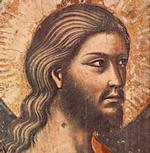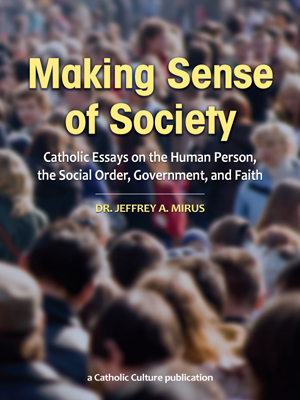The Father William Most Collection
Jean Guitton and the Mediatrix of All Graces
[Homiletic and Pastoral Review 53 (May 1953) pp.698-701]
WE WHO LIVE in this, the age of Mary,1 are privileged to see a most remarkable development of the dogmatic truths about Mary. This is in accord with the promise of Christ that He would send the Holy Spirit to "teach you all truth."2 For the Holy Spirit brings to the Church an ever clearer perception of the treasures contained in the original deposit of revelation.
In spite of this beneficial trend to ever greater comprehension of the privileges of Mary, some few writers still lag behind. It is good to be cautious, but the failure to keep pace with the official teaching of the Church is not caution; it is retrogression. From time to time one encounters a statement, written or oral, which expresses doubt on the doctrine that Mary is the Mediatrix of all graces. As an example, a widely publicized recent book, Jean Guitton's The Virgin Mary,3 makes this statement:
Many reviewers have given Guitton's book considerable credit for certain of its features. It does show much original thought. Reviewers, however are sometimes very busy men, who must attempt to survey large masses of new works monthly or even weekly. It is not, therefore, humanly possible that they should be able to note every slip. Hence, the above statement of Guitton seems, for the most part, to have escaped the reviewers. They commonly notice his minimistic attitude; they say, for example, that Guitton cuts through the accretion of mere sentiment. Sometimes, though, his scissors slip and go a bit farther. But, lest we make any unsupported statements, let us review briefly the evidence for the thesis that Mary is the Mediatrix of all graces.4
St. Paul often refers to Christ as the New Adam.5 We do not know if the early Fathers took a hint from those words of Paul, or whether, perhaps, they may have been guided by even more open oral statements of the Apostles. Whatever the case may be, from the earliest times the Fathers have insisted on speaking of Mary as the New Eve. It would be easy to fill several pages with Patristic texts of such a nature.6 The question which we must ask ourselves, then, is this: what did the Fathers mean by calling Mary the New Eve? They surely meant to compare and contrast her with the original Eve. But how far may we press this comparison? What may we see in it? We might speculate merely with the aid of our own reason, and thus conclude that, since the first Eve was immaculate before the fall, the New Eve, too, ought to be conceived Immaculate.7 In the document defining the Immaculate Conception, Pius IX does draw out just such an argument. May we also argue, since the first Eve was intended to be the "mother of all the living,"8 that Mary, too, was to be the mother of all the living. For the first Eve was intended to be, with Adam, the means of the transmission, by inheritance, of sanctifying grace to all future generations Tempting though it is to assent to this argument, the proper method of approach is to look to the official guidance of the Church.
Role of Mary from papal texts
There has been a great deal of misunderstanding in recent years, even among educated Catholics on the teaching authority of the Church. There have been, of course, no denials of solemn infallible definitions. Many, nevertheless, have thought themselves free to brush aside and call into doubt doctrines which are not solemnly defined, but which are taught clearly in lesser Papal texts, such as Encyclicals. Encyclicals, it should be noted, may also contain definitions. The Holy See has been much concerned over this recent attitude, with the result that the Holy Office, in an Instruction of Dec. 20, 1949,9 condemned this careless regard. The Holy Father, himself, also thought the matter serious enough to make this statement:10
Therefore, in order to be sure whether or not we are justified in deducing the doctrine of the Mediatrix of all graces from the New Eve concept, we must go to the Papal texts. These texts, fortunately, are abundant and clear.
Pope Leo XIII11 holds in one of his many encyclicals on the Rosary:
Still another statement of the same Pope is even more emphatic:13
We would be indeed surprised if Blessed Pius X did not give us at least a few words on this subject.14 In his classic Encyclical celebrating the 50th anniversary of the definition of the doctrine of the Immaculate Conception, he writes:15
Toward the end of the First World War, Pope Benedict XV heart-broken at the continuing struggle, wrote to Cardinal Gasparri concerning prayers for peace to be offered through Mary. In this letter he said:16
An examination of papal texts thus far reveals three of the Popes declaring unequivocally that all graces are dispensed through Mary. They are so clear that no commentary is required to bring out the sense. It was not, therefore, necessary that Popes Pius XI and Pius XII should restate this truth. Yet their love for the Mother of God constrained them to reiterate the teaching of their predecessors. Of the several statements of Pius XI, let us read merely one from an Encyclical on the Sacred Heart, in which, in the midst of the great depression,17 the Holy Father called for prayers through Mary:18
It is interesting to see that Pius XI not only teaches the doctrine, but even uses the expression, "Mediatrix of All Graces."
Our present Holy Father, Pope Pius XII, has sometimes been called "The Pope of Mary." In the Apostolic Constitution, in which the present Pontiff defined the dogma of the Assumption, he argued from the New Eve concept to the Assumption, itself.19 Hence it is not surprising that he also teaches plainly that Mary is the Mediatrix of all graces. In a broadcast to Fatima, he explained:20
Unanimity among theologians
As a result of pronouncements so numerous and so clear from so many Popes, it is not surprising that all professional theologians today teach the doctrine that Mary is Mediatrix of all graces. In fact, the Holy See, itself, found occasion to point out this unanimity. The Sacred Congregation of Rites, in approving two miracles for the canonization of St. Louis de Montfort, said (speaking now of St. Bernard):21
While it is interesting to note this mention of the unanimity of professional theologians, the teachings of the Popes are, themselves, amply sufficient. Guitton, strangely, apes not seem to acknowledge the existence of so many Papal texts regarding Mary.
A corollary now follows: since Mary is the Mediatrix of all graces, devotion to Mary may not be optional. To attempt to gain any grace, while deliberately ignoring the channel of all graces, is folly. Guitton, however, not recognizing Mary as the Mediatrix of all graces, is able to say of devotion to Mary:22
To which we reply by quoting again Pope Leo XIII:23
| 1 | Pope Pius XII privately expressed this opinion in a conversation with the Director of the General Secretariate of all Sodalities in Rome. Our Lady's Digest (Aug.-Sept., 1951) p. 119. |
| 2 | John xvi: 13. |
| 3 | The Virgin Mary. By Jean Guitton. Translated by A. Gordon Smith (P.J. Kenedy & Sons, N.Y., 1952), p. 138. |
| 4 | The term "Mediatrix of all graces" is sometimes used to refer only to the fact that all graces are distributed through Mary though some writers would make it include the fact of Mary's cooperation in earning all graces. In this article we use the term in the narrower sense without meaning to deny the other. We must also note that the question of precisely how Mary distributes all graces is at yet unsolved. It is clear that she does so at least by way of intercession, i.e., asking for all graces. There is no agreement among theologians however on whether or not all graces are transmitted in a physical way through her. |
| 5 | 1 Cor. xv: 45. |
| 6 | Mary in the Documents of the Church. By P. F. Palmer S. J. (Newman Press Westminster, Md., 1952), pp. 12 ff., 83, 99. The Blessed Virgin in the Fathers of the First Six Centuries. By T. Livius. (London 1893) pp. 47-59. |
| 7 | There would be this difference: Eve when first created did not need redemption for the fall had not taken place; Mary was Immaculate in virtue of the anticipated application to her of the merits of her Son. |
| 8 | Gen. iii: 20. |
| 9 | Acta Apost. Sed., XLII, p. 144. |
| 10 | "Humani generis." Acta Apost. Sed., XLII, p. 568. |
| 11 | Acta Sanct. Sed., XXVII, p. 179. |
| 12 | Notice that this text seems to favor the physical causality theory mentioned above in note 4. It is not conclusive, however. |
| 13 | Acta Sanct. Sed., XXIV, pp. 195-196. |
| 14 | The Homiletic and Pastoral Review, LII (Jan., 1952) pp. 311-14. |
| 15 | Acta Sanct. Sed., XXXVI, pp. 453-54. |
| 16 | Acta Apost. Sed., IX, p. 266. |
| 17 | Acta Apost. Sed., May 3, 1932. |
| 18 | NCWC edition (Vatican Press translation), pp. 21, 22. |
| 19 | Acta Apost. Sed., XLII. p. 768. |
| 20 | Acta Apost. Sed., XXXVIII, p. 266. Note that the Holy Father makes Mary associated with Christ in the work of the Redemption and forever remaining in that association. Thus, God has freely chosen to use Mary's services at every point, from the Annunciation to the distribution of the very last grace. Guitton must be questioned then, when he says (p. 2): "This discrepancy, between the place held by the Virgin in sentiment, practically so vast, and the very limited place she occupies in dogma ... constitutes a serious difficulty for many minds." |
| 21 | Acta Apost. Sed., XXXIV, p. 44. |
| 22 | Guitton, p. 2, op. cit. |
| 23 | Acta Sanct. Sed., XXX, p. 133. |






